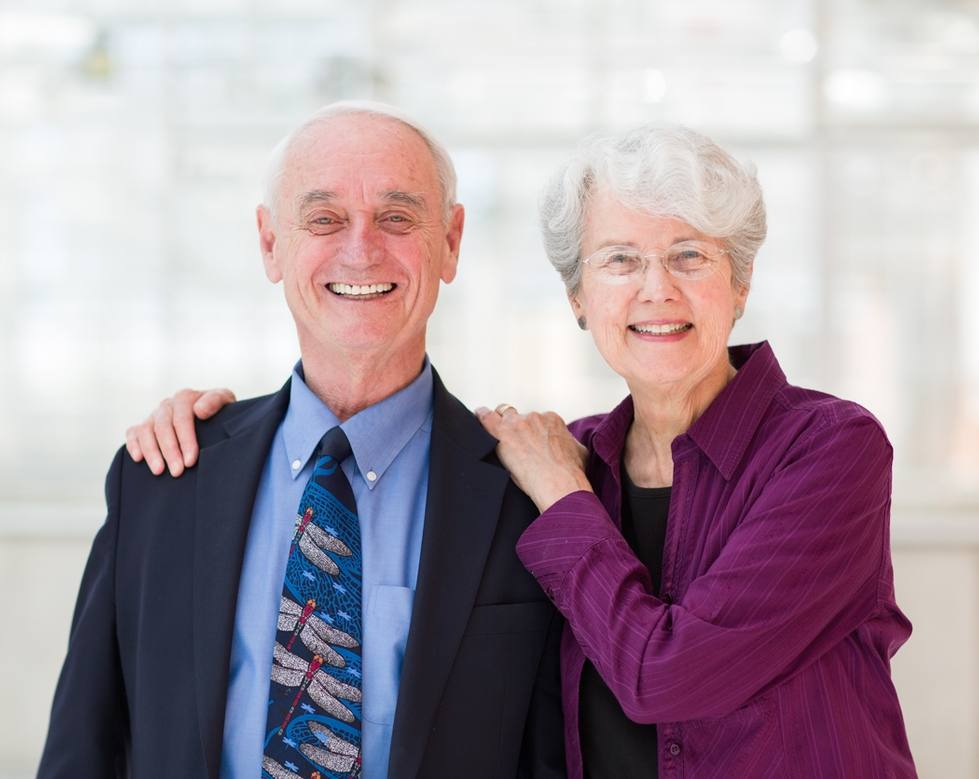Donor Impact Summer 2015
Donors help take science to new level
A dedication ceremony for the new science lab building on the Allendale Campus will take place August 28. In April, the building was named in honor of former Grand Valley dean and longtime faculty member Doug Kindschi.
The 151,000-square-foot P. Douglas Kindschi Hall of Science will help meet the demand for the STEM (science, technology, engineering and mathematics) and health professions fields. Grand Valley offers 86 undergraduate programs and 35 graduate programs, and more than 40 of them touch the STEM and health professions in some way.
“Doug’s generous gift will help provide support for materials, technology and research opportunities for students,” said President Thomas J. Haas. “We are tremendously grateful for Doug’s support and wanted to recognize that by naming this new building for the sciences in his honor.”

Doug and Barbara Kindschi
photo by Amanda Pitts
Kindschi is currently the director of the Kaufman Interfaith Institute at Grand Valley. He came to Grand Valley in 1976 and has served the university for 40 years in many capacities, including as a professor of mathematics and philosophy, and dean of the former Science and Mathematics Division.
“Grand Valley has been very good to me,” said Kindschi. “When I came here there were about 5,000 students. Now, there are more than 25,000. It’s been exciting to see the growth and I’ve had the privilege of being a contributing member of a vibrant university.”
The Kindschi Hall of Science was funded in part by the state of Michigan, but additional funds were needed to provide continued academic support for the teaching and learning taking place inside the building. The building features nine classrooms, 15 teaching laboratories, 14 faculty and student research laboratories, study spaces and offices.
The building also features the Barbara Kindschi Greenhouse, a 3,000-square-foot greenhouse with tropical, arid, temperate and quarantine bays for research and teaching.
“My wife, Barbara, and I had the opportunity to tour the building and it is very impressive,” said Kindschi. “When we came to the greenhouse, Barbara said she wanted to contribute to a fund on behalf of it. She likes to garden and always wanted a greenhouse. Now, she will enjoy seeing how students are learning to nurture plants.”
Kindschi has been actively engaged with elementary and secondary students in science education through his establishment of the Coalition for Excellence in Science and Math Education, Regional Math and Science Center and Science Olympiad tournaments, which give hundreds of area middle and high school students the opportunity to develop their talents in the STEM fields.
“Science isn’t just for science majors. Knowledge of science is important for many other fields like health, law and technology,” said Kindschi. “We need science knowledge to be informed citizens and to be able to understand certain issues when we vote. Science and mathematics are basic to so many other fields.”
Kindschi said he has been passionate about growing science education at Grand Valley and in the community since reading a report in the 1980s that said America was a nation at risk because education was lacking in the STEM areas.
“The importance of the sciences is a national need. What is our part in it? I can’t solve the whole thing but I can impact my community,” said Kindschi. “I am so pleased that our contribution will help students and faculty and the development of research and the education that is taking place inside the building — that is where my heart is,” he said.
Donor wall supports student research
The Kindschi Hall of Science will also feature a donor wall inside the building; anyone who makes a gift to the College of Liberal Arts and Sciences Margin of Excellence for Science Endowment Fund will be recognized on the donor wall. Gifts can be made in memory or in honor of individuals and those names will also be recognized on the donor wall.
The fund provides support for advanced scientific research opportunities for students majoring in the sciences, including working with faculty members, publishing and attending conferences. Approximately 2,300 students are currently pursuing degrees in the sciences, in programs such as biology, biomedical sciences, chemistry, geology and physics.
Grand Valley is working to expand support for undergraduate scientific research. The initiation of a “margin of excellence” program offers that possibility to a greater number of students who will work directly with faculty members to design and execute professional-level scientific research, which at most universities is offered only to graduate students.
Kindschi Hall of Science features
- 9 classrooms
- 29 teaching and research labs
- 3,000-square-foot greenhouse
- Approximately 2,300 students are pursuing degrees in the sciences
Students who participate in research have gone on to succeed in graduate studies and in the workforce.
Brianne Docter, ’13, graduated summa cum laude with a bachelor’s degree in chemistry from Grand Valley and is pursuing a doctorate in cellular and molecular biology from the University of Michigan. Docter conducted research as an undergraduate in the laboratory of Bradley Wallar, professor of chemistry.
The focus of her research was investigating how beta-lactamases break down antibiotics such as penicillin and are responsible for antibiotic resistance in certain strains of bacteria. In 2012, she was named a Goldwater Scholar, a prestigious award given to the nation’s most exceptional undergraduate STEM students.
Fred Antczak, dean of the College of Liberal Arts and Sciences, said: “These opportunities are making a difference for the students who will make a difference. Support for these programs will provide more students like Brianne with a competitive advantage as they move on to the next steps in their careers or education.”
